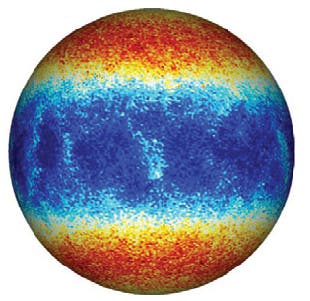We’ve written extensively before about the life harboring possibilities of Jupiter’s moon, the icy Europa. The moon is believed to be the likeliest candidate in our solar system, besides our own planet, capable of supporting life. Recently, a report compiled by researchers at University of Texas at Austin, the Georgia Institute of Technology, and the Max Planck Institute for Solar System Research modeled ocean currents and patterns beneath the moon’s icy crust and found it is likely these create enough heat and energy transfer to sustain life.

Zonal flows in Europa-like ocean simulation. Image credit: University of Texas Institute for Geophysics.
Previously, scientists have relied on valuable magnotometer readings supplied by the Galileo spacecraft, which orbits Europa, to estimate how conditions are like beneath the ice. This time, the researchers took a reverse path and looked at the effects to determine the cause. Namely, attention was shifted towards disrupted ice on the moon’s surface known as chaos terrains.
“The chaos terrains, which are concentrated in Europa’s equatorial region, could result from convection in Europa’s ice shell, accelerated by heat from the ocean,” explained lead author Krista Soderlund, from the University of Texas. “The heat transfer and possible marine ice formation may be helping form diapirs, or warm compositionally buoyant plumes of ice that rise through the shell.”
A warm ocean beneath an icy moon
The scientists compiled a numerical model of Europa’s ocean circulation and found that warm rising ocean currents near the equator and subsiding currents in latitudes closer to the poles could account for the location of chaos terrains and other features of Europa’s surface. The report follows that these patterns could help intensive natural turbulence, increasing heat transfer near the equator and initiate upwelling ice pulses that create features such as the chaos terrains. To support their reasoning, the researchers liken their conclusions to similar phenomenon observed on Earth.
“This tells us foundational aspects of ocean physics,” notes co-author Britney Schmidt, assistant professor at the Georgia Institute of Technology. More importantly, adds Schmidt, if the study’s hypothesis is correct, it shows that Europa’s oceans are very important as a controlling influence on the surface ice shell, offering proof of the concept that ice-ocean interactions are important to Europa.
“That means more evidence that the ocean is there, that it’s active, and there are interesting interactions between the ocean and ice shell,” says Schmidt, “all of which makes us think about the possibility of life on Europa.”
When the European Space Agency’s JUICE mission (JUpiter ICy moons Explorer) will be deployed to Europa, it will offer the necessary tools to test this hypothesis by probing into the characteristics of the ocean and ice shell through two flyby observations. NASA’s Europa Clipper mission concept, under study, would complement the view with global measurements.
Findings were reported in a paper published in the journal Nature Geoscience.









